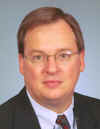April 2004
![]()
AutomatedBuildings.com
[an error occurred while processing this directive]
(Click Message to Learn More)
April 2004 |
[an error occurred while processing this directive] |
 EMAIL INTERVIEW
- Jay Althof & Ken Sinclair
EMAIL INTERVIEW
- Jay Althof & Ken Sinclair
Jay
Althof, Vice
President of Controls Product Planning and Support,
Trane, Global Controls and
Contracting
In late 2003, Trane hosted a number of key industry editors and publishers at an event to celebrate Trane's 25th anniversary in the controls business, and take a look ahead at the next 25 years in controls. The AutomatedBuildings.com editor was abroad and not able to attend, but later caught up with Vice President of Controls Product Planning and Support Jay Althof to pose a few questions on Trane's perspective.
In a recent interview with Automatedbuildings.com, Clasma CEO Anto Budiarjo included Trane among companies to watch in 2004. Anto said, " It will be very interesting to watch Trane. They were a company making mechanical boxes a few years ago, and now they make a significant amount of controls. Their vision is to become a significant player in integrated buildings."
|
[an error occurred while processing this directive] |
Trane and the next 25 years in controls
Sinclair: What are the big trends you see driving the building controls industry today?
Althof: We think the major trends can be grouped into three broad areas: technology, customer expectations and industry responses.
In the area of technology there are a couple of very important trends. Clearly, the impact of the internet and web services are going to be significant to the building controls industry. The convergence of multiple building sub-systems information management with IT-based infrastructure is starting to occur. While today this creates significant interoperability challenges, those technical issues will be addressed over the next few years. In addition, we believe that wireless communications will become sufficiently robust and cost effective for widespread use in commercial and institutional buildings within the next few years.
Customers generally have two growing needs. They need their interaction with building systems to be much easier. At the same time, they expect that these systems be able to further reduce overall operating costs. Clearly, there is a continuum of expectations, but successful companies will find ways to deliver simple, easy-to-use systems that also provide robust and sustainable methods to significantly reduce energy and maintenance costs
In response to these two customer trends, players in the building controls industry are alternatively investing, divesting and positioning themselves to find key niches or approaches to remain viable in the future. As such, we can expect some further consolidation within the building controls industry. It is also probable that new entrants will emerge in an attempt to take advantage of the convergence of the various systems with the IT infrastructure.
Sinclair: As a company to watch in 2004, what will the industry be seeing from Trane in the coming year and beyond?
Althof: There are two significant areas that we are putting extra attention.
First, is helping our customers with their broad needs for building sub-system integration. By providing the service of tying together key aspects of facility infrastructure (HVAC, lighting, fire systems, security, maintenance management, etc.) and then helping manage the information flow from those systems we can reduce the complexity and operating costs for building owners and managers.
Second, we are continuing our efforts in control system product improvements. We strive to have very easy to use systems and are continuing to find ways to reduce the overall installed cost of systems.
Sinclair: How do integrated systems add value to the building owner, the ultimate customer?
[an error occurred while processing this directive]Althof: We need to recognize that systems, integrated or not, only provide value if they are designed, installed and operating properly. That said, further value accrues through integration in two general ways. The first is simply reducing the cost and management attention needed to procure and manage systems supplied by multiple suppliers. By working with a trusted supplier, building owners can focus their attention on the critical needs of their business or organization.
The second way to get additional value is through optimizing the operation of the building by properly using information from the various systems. This can be as simple as integrating schedule to include HVAC and lighting or more complex by integrating card access systems to HVAC and lighting controls tuned to specific occupants present in the facility. By viewing the building as a strategic asset, information available through integrated systems provides the basis from which to improve energy efficiency, preventive maintenance and inventory control.
Sinclair: Jay, you were recently named to the CABA board of directors. CABA played a role in incubating the oBIX™ guidelines, but there is now debate about what path the guidelines should follow to become a standard?
Althof: We in the controls industry have a tendency to be drawn into debates on technology, sometimes at the expense of focus on the needs of building owners, operators, and occupants. Regardless of the means whereby oBIX™ becomes a standard, two things are clear. Information technology and the Web is the future of controls platforms. Trane is committed to playing a role that best helps develop the promise of XML-based systems.
[an error occurred while processing this directive]
[Click Banner To Learn More]
[Home Page] [The Automator] [About] [Subscribe ] [Contact Us]